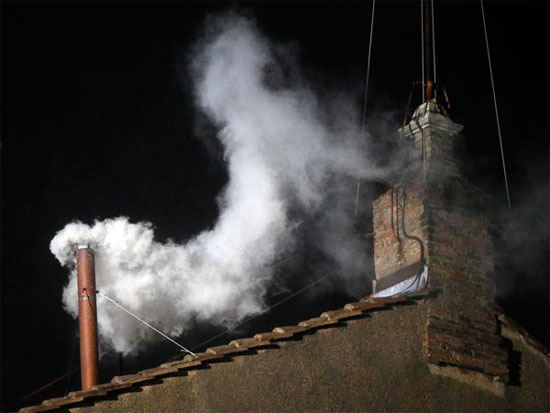Turn to the Holy See's smoke-making secret
The mysterious curtain around the black smoke, white smoke in the cardinals disappeared after the Vatican announced the chemicals that the Holy See used to create smoke.
Over the past two days, more than one billion Christians throughout the world have turned to the chimney of the Sistine Chapel on St Peter's Square in Vatican City to follow the outcome of the 266th papal election. White smoke escapes from copper chimneys. means the cardinals have chosen the new pope. But if black smoke escapes, the parishioners will have to keep waiting.

White smoke rises from the chimney of the Sistine Chapel after
cardinals elected a new pope on the evening of March 13. (Photo: AP)
For hundreds of years, the secret to creating black smoke, white smoke of the Holy See is a mystery to the public. But on March 12, the Vatican press office revealed how to create smoke. Earlier, a Holy See spokesman said only that smoke was made of many different chemical elements.
Both the recipe for black smoke and white smoke are like the standard fireworks recipe, The New York Times reported. White smoke is made from potassium chloride (KClO 3 ), milk sugar (which helps the mixture catch fire more easily), rosin.
Meanwhile, black smoke is made from potassium perchlorate (KClO 4 ), anthracene (C 14 H 10 ) and sulfur (the substance used to burn). Potassium chloride and potassium perchlorate are two compounds with similar chemical properties, but many chemists prefer potassium perchlorate because it is more stable and safe.
People burn electricity with electricity in a special oven. This stove, located in the Sistine Chapel, was first used in the cardinal's 2005 petition. It is located next to the old kiln, which was used to burn the votes in previous cardinals. The smoke of chemicals will be mixed with smoke burning cardinals, passing through the roof of the Sistine Chapel to enter the air, signaling to the followers.
- Secret of preventing toxic smoke when the apartment is burnt
- Strange frogs turn themselves into magnets ... suck bait
- Life in the sea of smoke in Indonesia
- Found the legendary Holy Grail?
- He discovered the holy well
- The priceless image of the famous Holy land in history
- Decode the half-day melting ice making technology
- An interesting 'illusion' created from smoke
- Biology
- The mystery of the 'strange smoke' on Mars
- Smoke is more toxic than cigarette smoke
- Village men are always excited because they smoke Viagra all day
 'Fine laughs' - Scary and painful torture in ancient times
'Fine laughs' - Scary and painful torture in ancient times The sequence of numbers 142857 of the Egyptian pyramids is known as the strangest number in the world - Why?
The sequence of numbers 142857 of the Egyptian pyramids is known as the strangest number in the world - Why? History of the iron
History of the iron What is alum?
What is alum?